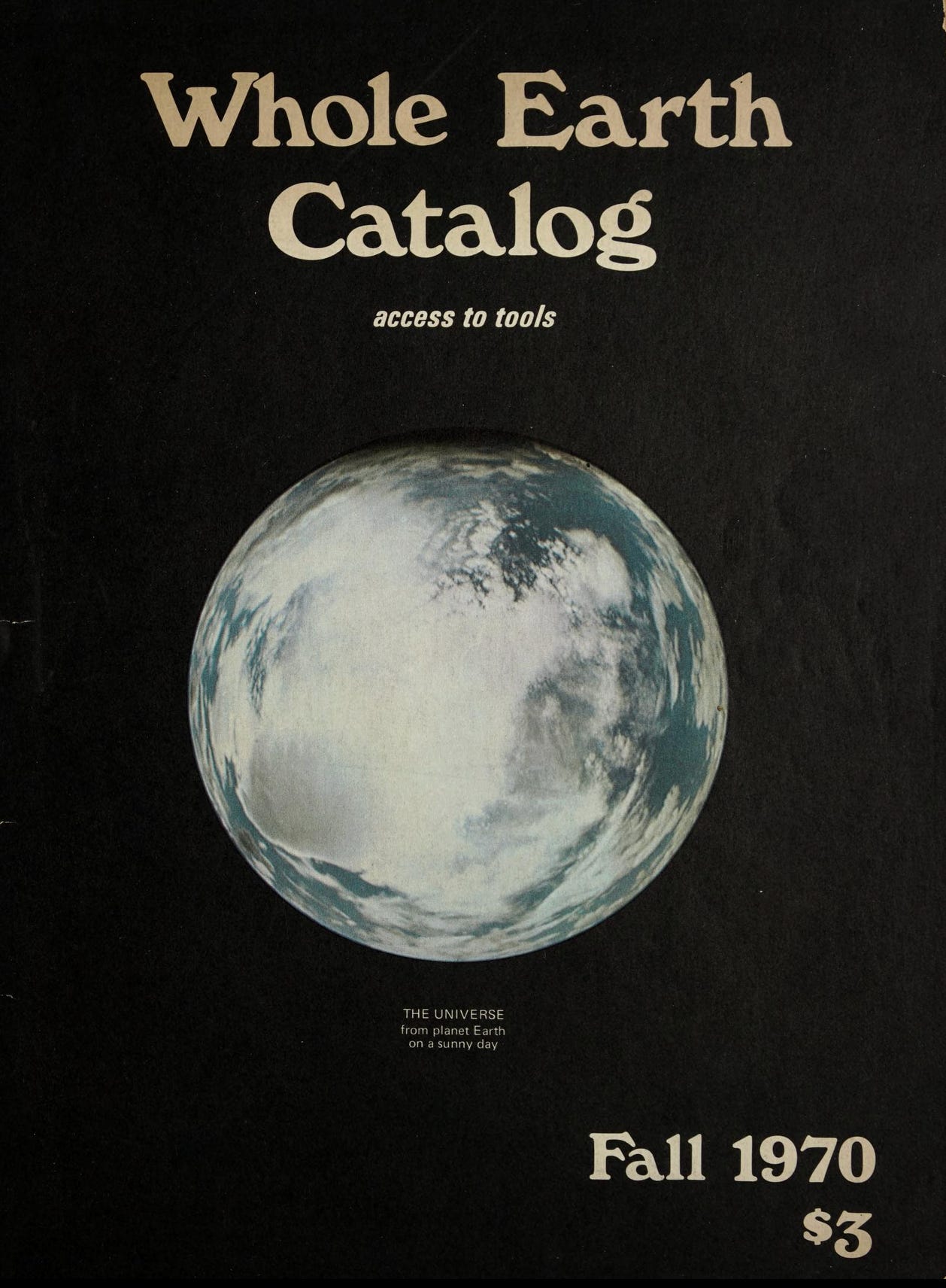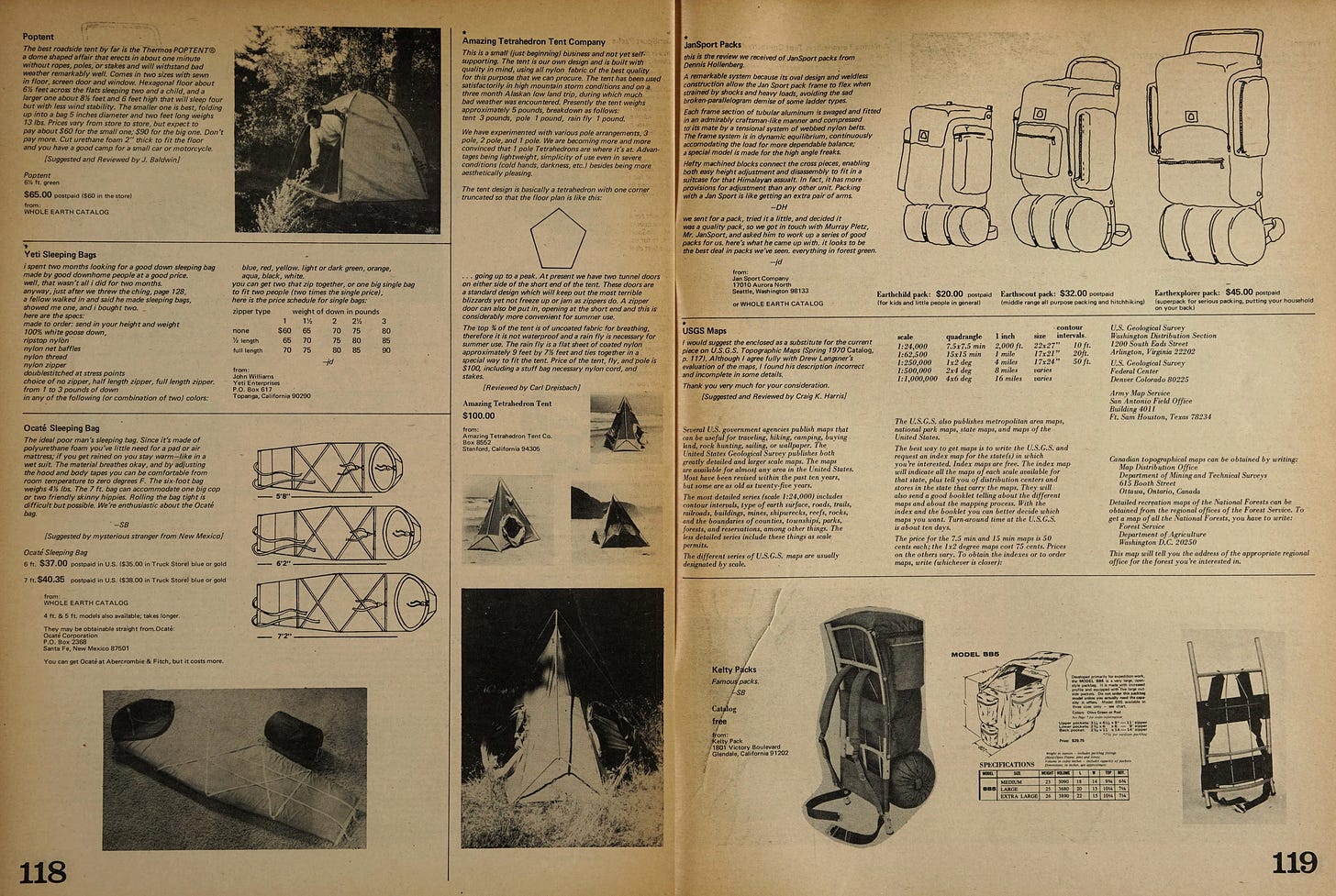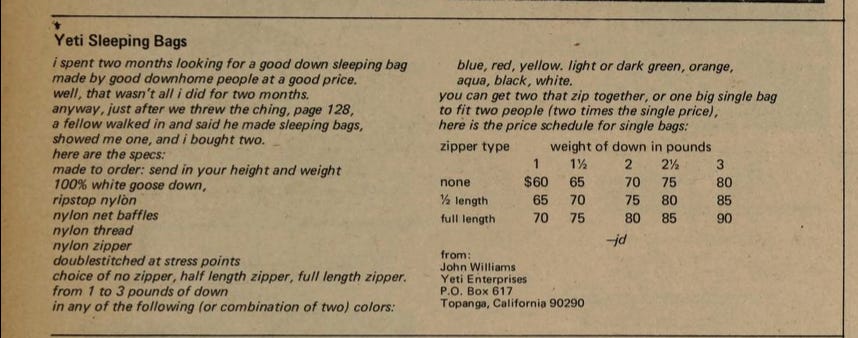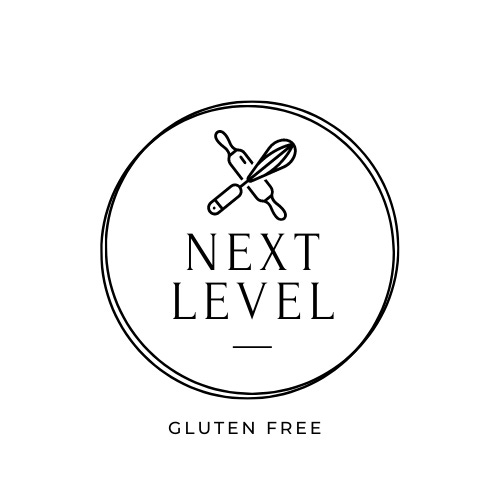# 234 : A Trip Down Memory Lane
A sleeping bag, a road trip, and a first lesson cooking dry beans in the early 70s where I learned a lot!
Do you remember the first time you cooked with dry beans? I sure do. What could be difficult about cooking a cup of dry red beans? Put ‘em in a pot, cover with water, and they should be done in about the same time as oatmeal, right? Was I ever wrong!
Preparing for a 70s Road Trip
As many of us did back in the 70s, I poured over the pages of the Whole Earth Catalog (WEC), which is now online for trips down memory lane, and decided that I needed a sleeping bag.
I just knew that my very own sleeping bag would be a very cool and useful thing to have, along with hiking boots and Levi 501 button up jeans. Remember those?
On page 118 of WEC, I found mention of what sounded to me like the best sleeping bag in the world made to order by John Williams of Yeti Enterprises, although never having had a sleeping bag before I had no idea what constituted a good bag.
While writing this piece, I learned that John Williams later designed the first Automated Web Canopy Exploration system for traversing the rain forest canopy in Costa Rica. You can read more of this here: https://www.alternativeprojections.com/assets/Uploads/Micheal-Scroggins-Oral-History-Transcript.pdf on page 76.
It truly is amazing what you can find when you go down rabbit holes on the Internet.This was, of course, pre-internet days so first I sent a letter to the maker with some questions. How many pounds of down should my bag have? Half or full-length zipper? I received a reply by mail a few weeks later. Mr Yeti, as I now thought of him, said he thought 1-1/2 pounds would do fine and so would a 1/2 length zipper. I wrote back with a YES and included the payment, which was probably cash as I don’t recall that I had a checking account at that time. Then I awaited my very cool Yeti sleeping bag.
A few months earlier, when I pulled my twin size mattress out on to our 2nd story balcony to sleep, my mom shook her head in disbelief and asked why. I told her that I loved feeling the cool air on my face. She suggested opening a window instead but being a teenager who knew everything, (Mom, wherever you are now, please forgive me.), I probably said something like, You just don’t get it. When my new brilliant blue sleeping bag and stuff sack with the face of a yeti on it arrived, I decided to sleep out under a tree in the back yard. I knew my bag was going to be so cozy warm. Mom shrugged her shoulders.
That first night was, in a word, wretched. I didn’t know how very hard and damp the ground would be and I was not toasty warm. I was miserably cold. But I was determined to gut it out and having sort of made it through the night, Mom didn’t say anything disparaging to me when I came inside early—very very early—the next morning. She seemed much at ease when I took my new Yeti bag and headed back to sleep on the balcony mattress with it for it’s second night…still cold, but at least softer.
On the Road
Having recently graduated from high school, my friend Linda and I decided it would be fun to mark the occasion by taking a car camping road trip together. On the appointed date, with my Yeti bag, clothes, and some bread, cheese, fruit, and water for sustenance, all stuffed in to my yellow 1971 VW bug. We picked up Highway 101 North in our hometown of Santa Barbara and off we went.
Where to? San Francisco? Berkeley? Sonoma? The Redwoods? Other than north, we had no real plan of where we were going or where we would stay, but, being young, it would be an adventure.

A few hours up the road was the turn off for Highway 1. That would take us through The Big Sur, a place of myth, mystery and ultimate coolness in our minds. With each bend of the road there were beautiful vistas and we recognized names like Esalen and Nepenthe. We couldn’t afford the prices of Nepenthe’s cafe so headed up the road to Julia Pfeiffer Burns State Park to eat our bread and cheese and spend the night.

There was no lottery for campsites back then like there is today and the campground was pretty empty so we had many sites from which to choose. We pulled into one, set our sleeping bags out on the ground as we had no tent, and had our little supper. By now, I had a sleeping pad so as I slept near big trees, feeling the cool moist air on my face and listening to the quiet of the night, my backside was a little more comfortable with the addition of the sleeping pad.
Join me on Saturday June 8th for a special pie dough session held virtually just for paid subscribers.
The next morning we continued north passing through Carmel and Santa Cruz on the way to San Francisco. Linda had the address of someone-who knew-someone-who knew-someone-else that might be willing to put us up for the night in Oakland so finding a route with a folded paper map (remember those?) we passed the land of the Golden Gate and turned east to cross the San Mateo Bridge and found the Oakland address. We knocked on the door and, low and behold, were told we could stay!
Just make yourselves at home and use anything in the kitchen, too. In the morning, I decided to make oatmeal for breakfast. There were some dry red beans in a jar on the counter and I thought I’d add a few to the oats, too. I hadn’t grown up cooking with dried beans so in all honesty I had absolutely no idea how or what to do with them.
As Linda headed to take her shower I asked, Should I put some beans in with the oats? and her saying something like, I guess.
And so I did.
I put hard dry red beans in to the pot with old-fashioned rolled oats, added water, brought everything to a boil, figuring I would let everything simmer until the oats were done. How hard could that be? Well, just about everything.
When the oats were done, the beans were still as hard as rocks or in this case as hard as dry beans can be. I added more water and continued the cooking in hopes the beans would soften up. When we sat down to eat, Linda looked at what I had attempted to cook—oat mush and hard beans—and I fessed up to not knowing the first think about cooking dry beans. While we pulled them out one by one, she said her mom always soaked them first. I can’t say that the mush that I made, flavored with essence of dry beans, is anything I would make or care to eat again. But, mistakes make for great learning!
So, last week, when a friend, who had never cooked dry beans, asked if I might show how it was done, and remembering my inedible attempt of 50+ years ago, I was more than happy to oblige.
What about you? Have a bean disaster you care to share with us?
A Few Hints for Cooking Dry Beans from Home Cooking
I used to soak dry beans overnight before cooking them, but over the years found that I get the same results by bringing the beans to a boil for a few minutes, letting them sit for an hour or two, and then cooking. And lest you think that you can’t make a recipe at the last minute if you’ve forgotten to soak and cook them, canned beans are just the ticket.
If dry beans won’t soften after a long cook, most likely it is because they are old and stale. Whether buying in bags or from the bulk bin, buy from a store that has a good turnover of products to ensure that the beans are fresh.
Either way you do it, beans will soak up quite a bit of water while cooking, so do check in on them regularly to see if you need to add more. I add hot boiling water from my tea kettle to keep the beans at a steady cooking temperature.
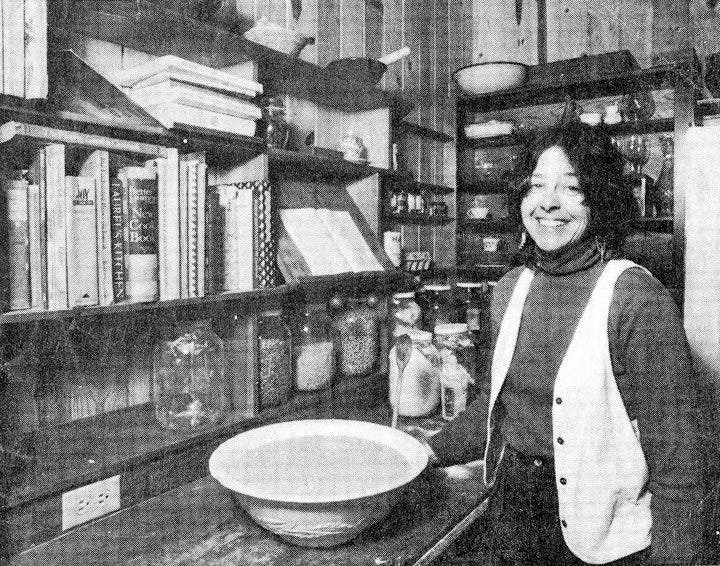
Coming up on Wednesday of this week, a special guest post by Rachel Ciordas of Next Level Gluten Free that you won’t want to miss whether you are gluten-free or gluten-full!





